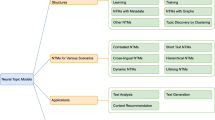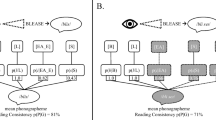Abstract
Generating informational thesauri that classify, cross-reference, and retrieve diverse and highly detailed neuroscientific information requires identifying related neuroanatomical terms and acronyms within and between species (Gorin et al., 2001) Manual construction of such informational thesauri is laborious, and we describe implementing and evaluating a neuroanatomical term and acronym reconciliation (NTAR) system to assist domain experts with this task. NTAR is composed of two modules. The neuroanatomical term extraction (NTE) module employs a hidden Markov model (HMM) in conjunction with lexical rules to extract neuroanatomical terms (NT) and acronyms (NA) from textual material. The output of the NTE is formatted into collections of term- or acronym-indexed documents composed of sentences and word phrases extracted from textual material. The second information retrieval (IR) module utilizes a vector space model (VSM) and includes a novel, automated relevance feedback algorithm. The IR module retrieves statistically related neuroanatomical terms and acronyms in response to queried neuroanatomical terms and acronyms. Neuroanatomical terms and acronyms retrieval obtained from term-based inquiries were compared with (1) term retrieval obtained by including automated relevance feedback and with (2) term retrieval using “document-to-document” comparisons (context-based VSM). The retrieval of synonymous and similar primate and macaque thalamic terms and acronyms in response to a query list of human thalamic terminology by these three IR approaches was compared against a previously published, manually constructed concordance table of homologous cross-species terms and acronyms. Term-based VSM with automated relevance feedback retrieved 70% and 80% of these primate and macaque terms and acronyms, respectively, listed in the concordance table. Automated feedback algorithm correctly identified 87% of the macaque terms and acronyms that were independently selected by a domain expert as being appropriate for manual relevance feedback. Context-based VSM correctly retrieved 97% and 98% of the primate and macaque terms and acronyms listed in the term homology table. These results indicate that the NTAR system could assist neuroscientists with thesauri creation for closely related, highly detailed neuroanatomical domains.
Similar content being viewed by others
References
Altschul, S.F., Madden, T.L., Schaffer, A.A., Zhang, J.Z., Miller, W., and Lipman, D. (1997) Gapped BLAST and PS-Blast: a new generation of protein database search programs. Nucleic Acids Res. 25(17), 3389–3402.
American Heritage Dictionary of the English Language, Fourth Edn., 2000, Houghton-Mifflin, Boston, MA.
Baeza-Yates R. and Riberia-Neto, B. (1999) Modern Information Retrieval. Addison-Wesley (ACM Press series).
Bowden, D.M. and Dubach, M.F. (2003) Neuronames. Neuroinformatics. 1, 43–60.
Berrois, C.D, Cucina, J.R., Fagan, M.L. (2002) Methods from Semi-automated indexing for High Precision Information Retrieval. JAMA9(6).
Crestani, F., Neural Relevance Feedback for Information Retrieval. In: Uncertainty in Intelligent and Information Systems, B. Bouchon-Meunier, R.R. Yager, and Zadeh L.A. (eds.), World Scientific, Singapore.
Cristianini, N., Kandola J., Vinokourov, A., and Shawe-Taylor, J. Kernel methods for text processing. In: Advances in Learning Theory: Methods, Models and Applications, NATO-ASI series in Computer and System Sciences, Suykens, J.A.K., Horvath, G., Basu, S., Micchelli, C., and Vanewalle, J. (eds.) IOS, Amsterdam.
Frakes W.B. and Baeza-Yates R. (eds.) (1992) Information Retrieval: Data Structures and Algorithms. Prentice Hall, Englewood Cliffs, NJ.
Gorin, F., Hogarth, M., and Gertz, M. (2001) The challenges and rewards of integrating diverse neuroscience information Neuroscientist 7, 18.
Grefenstette G. (1994) Explorations in Automatic Thesaurus Discovery, Kluwer Academic, Boston.
Gusfield D. (1997) Algorithms on Strings, Trees and Sequences: Computer Science and Computational Biology, Press Syndicate of the University of Cambridge, Cambridge, UK.
Hassler R. (1959) Anatomy of the Thalamus: Introduction to the Stereotaxis with an Atlas of the Human Brain, Thieme, New York.
Homayouni, R., Heinrich, K., Wel, L., Cui, Y., Zhou, M., and Berry, M. (2003) Mining the Bibliome to Identify Functional Relationships Between Genes, UT-ORNL Bioinformatics Summit.
Jones, E.G. (1998) The thalamus of primates, in Handbook of Chemical Neuroanatomy, Vol. 14. Elsevier, Amsterdam.
Lamping, J. and Rao, R. (1994) “Laying out and Visualizing Large Trees Using a Hyperbolic Space.” Proceedings of UIST’94, November: pp. 13–14.
Leroy, G., Chen, H., and Jesse, D.M. (2003) A shallow parser based on closed-class words to capture relations in biomedical text. J. Biomed. Informatics 36, 145.
Liu, H., Johnson, S.B., and Friedman, C. (2002) Automatic resolution of ambiguous terms based on machine learning and conceptual relations in the UMLS. J. Am. Med. Inform. Assoc. 9(6), 621–36.
Liu, H., Teller, V., and Friedman, C. (2004) A multi-aspect comparison study of supervised word sense disambiguation. J. Am. Med. Inform. Assoc. 11(4), 320–331.
Mao, W. and Chu, W.W. (2002) Free text medical document retrieval via phrase-based vector space model. Proceedings of AMIA Annual Symposium.
Magnus, S. (2001) Vector-based semantic analysis: representing word meanings nased on random labels. Semantic Knowledge Acquisition and Categorization Workshop, ESSLI, Helsinki, Finland.
Nomadic, G., Spastic, I., and Ananiadou S. (2002) Automatic discovery of term similarities using pattern mining. Proceedings of Second International Workshop on Computational Terminology-Computer, Taipei, Taiwan.
Olszewski, J. (1952) The Thalamus of the Macaca Mulatta, An Atlas for Use With the Stereotaxic Instrument. Krager, Basel.
Patwardhan, S., Banerjee, S., and Pedersen, T. (2003) Using measures of semantic relatedness for word sense disambiguation. Proceedings of the Fourth International Conference on Intelligent Text Processing and Computational Linguistics, Mexico City.
Porter, M. F. (1980) An algorithm for suffix stripping. Program 14(3), 130–137.
Pustejovsky, J., Castano, J., Cochran, B., Kotecki, M., Morrell, M., and Rumshisky, A. (2001) Linguistic Knowledge Extraction from Medline: Automatic Construction of an Acronym Database. Medinfo.
Qtag v 3.01, Portable POS Tagger. Oliver Mason, Department of English, School of Humanities, University of Birmingham, UK. http://web.bham.ac.uk/O.Mason/
Raghaven, V.V., Jung, G.S., and Bollmann, P. (1989) A critical investigation of recall and precision as measures of retrieval system performance. ACM Trans Info Systems 7(3), 205–229.
Ratnaparkh, A. (1997) MXTERMINATOR.
Rindflesh T., Hunter L., and Aronson, A. (1999) Mining molecular binding terminology from biomedical text. Proceedings of AMIA Annual Symposium.
Rindflesh, T., Rajan, J., and Hunter, L. (2000) Extracting molecular binding relationships from biomedical text. Proceedings of the 6th Applied Natural Language Processing Conference, pp. 188–195.
Salton, G., Wong, A., and Yang, C.S. (1975) A vector space model for automatic indexing, in Communica-tions of the ACM, Vol. 18. p. 613.
Salton, G. and McGill, M.J. (1983) In: Introduction to Modern Information Retrieval, Stewart, C.E. and Vastyan, J.E (eds.) McGraw-Hill, NY.
Salton, G. (1971) The SMART Retrieval System. Experiments in Automatic Document Processing. Prentice Hall, Englewood Cliffs, NJ.
Salton, G. and Buckley, C. (1990) Improving retrieval performance by relevance feedback, J. Am. Soc. Info Sci. 41(4), 288–297.
SPECIALIST Lexicon. National Library of Medicine, Unified Medical Language System (UMLS) Project.
Srinivas, P.R., Gusfield, D., Mason, O., et al. (2002) Neuroanatomical term generation and comparison between two terminologies, Neuroinformatics 1, 177.
Manning, C.D. and Schutze, H. (2000) Foundations of Statistical Natural Language. Mit Press, Cambridge, MA.
Yao, D. et al. Pathway Finder: paving the way towards automatic pathway extraction in ACM International Conference Proceeding Series Archive. Proceedings of the Second Conference on Asia-Pacific Bioinformatics, 29, pp. 53–62.
Author information
Authors and Affiliations
Corresponding author
Rights and permissions
About this article
Cite this article
Srinivas, P.R., Wei, SH., Cristianini, N. et al. Comparison of vector space model methodologies to reconcile cross-species neuroanatomical concepts. Neuroinform 3, 115–131 (2005). https://doi.org/10.1385/NI:3:2:115
Issue Date:
DOI: https://doi.org/10.1385/NI:3:2:115




